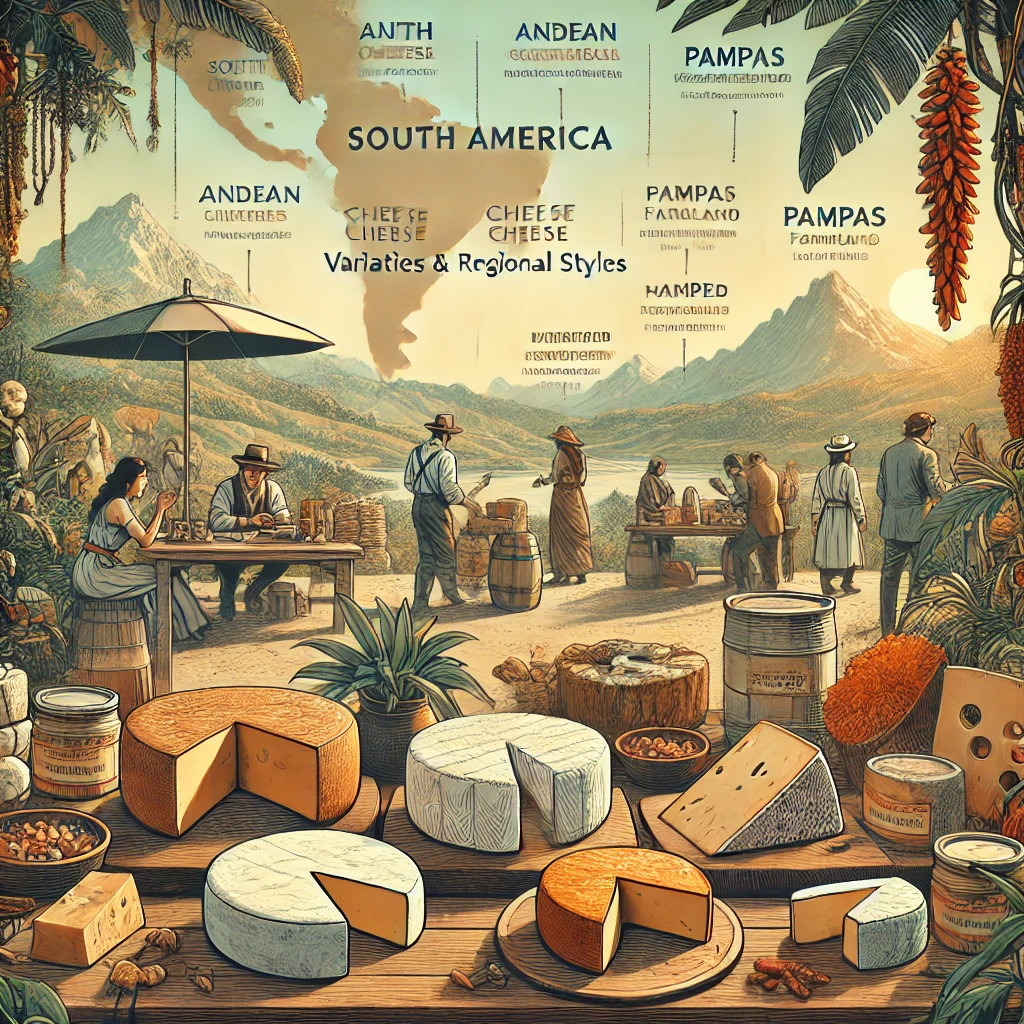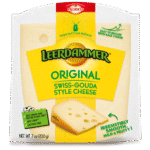South America may not be the first region people think of when discussing cheese, but the continent offers a remarkable diversity of dairy traditions shaped by Indigenous culture, Spanish colonisation, Andean farming, and tropical adaptations. From salty coastal cheeses to creamy Amazonian varieties and rich Andean blocks aged in high-altitude climates, South America’s cheese culture is both ancient and rapidly evolving.
Whether you’re a food enthusiast, traveller, or chef, this guide provides a full overview of the most popular South American cheeses, their regional styles, flavour profiles, and how they are traditionally enjoyed.
🌎 The History of Cheese in South America
Cheese-making in South America emerged from a blend of:
-
Indigenous agricultural practices
-
European dairy techniques, especially Spanish and Portuguese
-
Unique local climates, from Andean mountains to Patagonian plains
-
Cattle and goat farming introduced during the colonial era
While European settlers brought the concept of cheese-making, South American communities adapted techniques using local milk, tools, and climates. This is why cheese in South America often tastes fresher, saltier, and less aged than European varieties.
Today, the region produces both traditional cheeses and modern artisanal varieties inspired by European styles such as brie, gouda, and Parmesan.
🧀 Major Cheese Regions Across South America
South America’s cheese landscape can be divided into four dominant regions:
1️⃣ The Andean Highlands
Countries: Peru, Bolivia, Ecuador
-
High-altitude climates perfect for semi-hard cheeses
-
Goat, sheep, and cow milk commonly used
-
Known for salty, crumbly, fresh cheeses
2️⃣ Southern Cone (Argentina, Chile, Uruguay)
-
European-style dairy traditions
-
Semi-hard and aged cheeses are common
-
Large-scale dairy production and artisanal creameries
3️⃣ Brazil
-
Tropical cheeses with unique textures
-
Both fresh and stretched-curd varieties
-
Strong cheese culture in Minas Gerais region
4️⃣ Caribbean Coast (Colombia, Venezuela)
-
Light, fresh, salty cheeses ideal for hot climates
-
Often served with corn-based dishes (arepas, cachapas)
Each region offers something distinct, shaped by local tastes and climate conditions.
🧀 Top South American Cheeses (Country by Country)
Below is a country-specific guide to the most iconic cheeses in South America.
🇦🇷 Argentina
Argentina’s cheese culture is heavily influenced by Italy and Spain, thanks to massive immigration in the 19th and 20th centuries.
1. Queso Cremoso
-
Soft, mild, meltable
-
Used for pizza, sandwiches, and milanesas
2. Provoleta
-
Argentine version of provolone
-
Seasoned with oregano and chilli
-
Grilled and served as a starter for BBQs (asado)
3. Reggianito
-
Inspired by Italian Parmigiano Reggiano
-
Hard, salty, perfect for grating
-
Aged faster due to smaller wheel size
4. Pategrás
-
Semi-hard, nutty
-
Often compared to gouda
-
Ideal for snacking and sandwiches
Argentina’s cheeses are widely used in grilling and hearty dishes, reflecting the country’s strong barbecue culture.
🇺🇾 Uruguay
Uruguay, like Argentina, has strong dairy farming traditions.
1. Queso Colonia
-
Semi-hard, smooth, mild
-
Developed by Swiss and German immigrants
-
Great table cheese
2. Queso Dambo
-
Soft, buttery flavour
-
Melts well for sandwiches
Uruguay’s cheeses often complement the country’s famous beef dishes.
🇨🇱 Chile
Chile produces both fresh and aged cheeses, with a climate suitable for dairy farming.
1. Queso Chanco
-
Semi-soft, creamy
-
Mild flavour, melts beautifully
2. Queso de Cabra (Goat Cheese)
-
Strong, tangy, artisanal
-
Often made in northern arid regions like Coquimbo
Chile’s cheeses are commonly paired with seafood and crisp white wines.
🇧🇷 Brazil
Brazil offers some of the most unique cheeses in the continent, shaped by tropical conditions and regional flavour preferences.
1. Queijo Minas
-
Brazil’s most famous cheese
-
Fresh, moist, mild
-
Used in pão de queijo (Brazilian cheese bread)
2. Queijo Coalho
-
Firm, salty, skewered and grilled
-
Popular beach snack in the Northeast
3. Catupiry
-
Soft, creamy spreadable cheese
-
Used in pizzas, pastries, and stuffed chicken
4. Requeijão
-
Creamy cheese similar to cream cheese
-
Eaten with bread, tapioca, or mixed into sauces
Brazil’s cheeses reflect the country’s diverse climates and culinary creativity.
🇵🇪 Peru
Peru’s high-altitude conditions create cheeses with intense, salty flavours.
1. Queso Andino
-
Fresh, crumbly, salty
-
Made from cow or goat milk
-
Used in soups, salads, and snacks
2. Queso Paria (Ayacucho)
-
Semi-soft, buttery
-
Mild flavour, melts easily
3. Queso Serrano
-
Stronger, aged variety
-
Often enjoyed with potatoes or corn
These cheeses pair perfectly with Peru’s traditional Andean dishes.
🇪🇨 Ecuador
Ecuador’s cheeses are fresh, simple, and widely used with plantains and soups.
1. Queso Fresco
-
Soft, white, lightly salted
-
Served with fried plantains and soups
2. Queso de Hoja
-
Stretched-curd cheese wrapped in leaves
-
Mild flavour with a stringy texture
3. Quesillo
-
Very thin, elastic cheese
-
Similar to mozzarella
🇨🇴 Colombia
Colombia’s cheese culture is light, fresh, and heavily tied to breakfast dishes.
1. Queso Costeño
-
Salty, crumbly
-
Popular on the Caribbean coast
2. Queso Campesino
-
Soft, fresh, unsalted
-
Used in soups like ajiaco and changua
3. Queso Cuajada
-
Mild, yoghurt-like texture
-
Often eaten with cane syrup (melao)
4. Quesillo (Colombian Style)
-
Soft, stringy cheese
-
Used in arepas, empanadas, and desserts
🇻🇪 Venezuela
Venezuela produces some of the most iconic Latin cheeses used in arepas and cachapas.
1. Queso Blanco
-
Fresh, soft, salty
-
Melts perfectly inside arepas
2. Queso Guayanés
-
Creamy, buttery, semi-soft
-
Ideal for melting
3. Queso de Mano
-
Stretchy, mozzarella-like
-
Used in cachapas (sweet corn pancakes)
🧀 Regional Cheese Styles Across South America
Here’s a quick breakdown of the main styles:
🟡 Fresh Cheeses
-
Queso fresco (Ecuador, Peru)
-
Queso blanco (Venezuela)
-
Queijo Minas (Brazil)
-
Queso campesino (Colombia)
Mild, soft, lightly salted — often eaten daily.
🟠 Semi-Hard Cheeses
-
Queso Chanco (Chile)
-
Queso Colonia (Uruguay)
-
Queso Paria (Peru)
Nutty, buttery, great for melting.
🔴 Aged Cheeses
-
Reggianito (Argentina)
-
Queso Serrano (Peru)
Sharper flavours, perfect for grating or pairing with meat.
🟢 Stretch-Curd Cheeses
-
Queso de Mano (Venezuela)
-
Quesillo (Ecuador)
-
Queijo Coalho (Brazil)
Elastic, stringy, often grilled or stuffed in breads.
🧀 How South Americans Use Cheese in Cuisine
Cheese appears in daily meals across the continent:
-
Arepas stuffed with queso blanco or guayanés
-
Pão de queijo (Brazilian cheese bread)
-
Empanadas filled with fresh cheese
-
Grilled cheese on sticks at Brazilian beaches
-
Peruvian soups finished with queso fresco
-
Argentinian provoleta served sizzling at BBQs
-
Colombian hot chocolate paired with cheese (!)
Yes — in Colombia, cheese is dipped into hot chocolate, a beloved sweet-salty pairing.
⭐ Final Summary
South America’s cheese culture is diverse, rich, and deeply rooted in local traditions. From salty Venezuelan white cheeses to creamy Brazilian Minas and aged Argentinian hard wheels, the continent offers varieties that are as unique as its landscapes.
Whether you’re exploring street food, cooking traditional dishes, or tasting artisanal cheeses, South America offers an exciting world of flavours waiting to be discovered.
FAQs — South America Cheese Guide
1. What is the most famous cheese in South America?
Queijo Minas (Brazil) and queso blanco (Venezuela/Colombia) are among the most widely consumed.
2. Which South American country produces the most cheese?
Brazil and Argentina lead in production due to large dairy industries.
3. What cheeses pair well with South American dishes?
Fresh cheeses like queso fresco or queso blanco pair well with corn-based foods like arepas and empanadas.
4. Are South American cheeses aged like European cheeses?
Some are, such as Argentine Reggianito, but most are fresh or semi-hard.
5. What cheese is used in Brazilian pão de queijo?
Queijo Minas, a fresh, slightly salty cheese from the Minas Gerais region.



